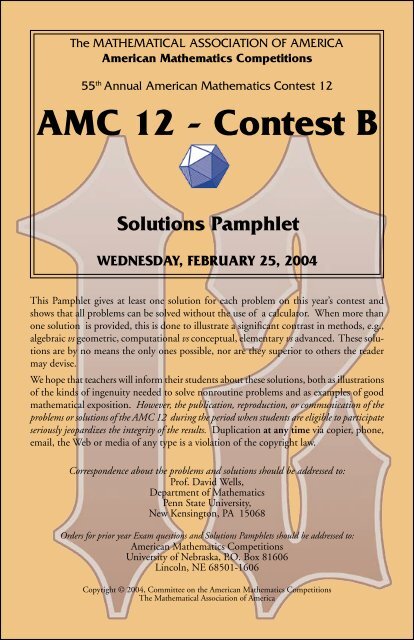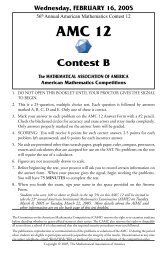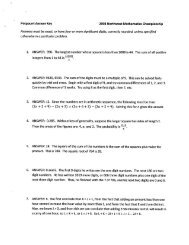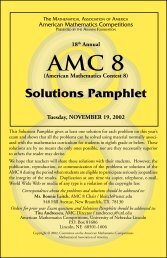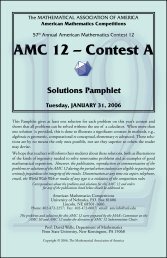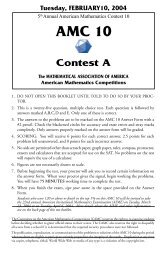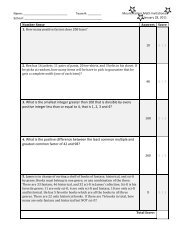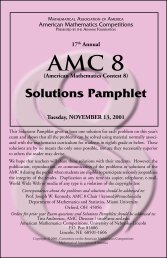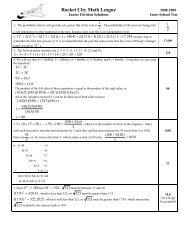2004 AMC 12B Solutions
2004 AMC 12B Solutions
2004 AMC 12B Solutions
You also want an ePaper? Increase the reach of your titles
YUMPU automatically turns print PDFs into web optimized ePapers that Google loves.
The MATHEMATICAL ASSOCIATION OF AMERICAAmerican Mathematics Competitions55 th Annual American Mathematics Contest 12<strong>AMC</strong> 12 - Contest B<strong>Solutions</strong> PamphletWEDNESDAY, FEBRUARY 25, <strong>2004</strong>This Pamphlet gives at least one solution for each problem on this year’s contest andshows that all problems can be solved without the use of a calculator. When more thanone solution is provided, this is done to illustrate a significant contrast in methods, e.g.,algebraic vs geometric, computational vs conceptual, elementary vs advanced. These solutionsare by no means the only ones possible, nor are they superior to others the readermay devise.We hope that teachers will inform their students about these solutions, both as illustrationsof the kinds of ingenuity needed to solve nonroutine problems and as examples of goodmathematical exposition. However, the publication, reproduction, or communication of theproblems or solutions of the <strong>AMC</strong> 12 during the period when students are eligible to participateseriously jeopardizes the integrity of the results. Duplication at any time via copier, phone,email, the Web or media of any type is a violation of the copyright law.Correspondence about the problems and solutions should be addressed to:Prof. David Wells,Department of MathematicsPenn State University,New Kensington, PA 15068Orders for prior year Exam questions and <strong>Solutions</strong> Pamphlets should be addressed to:American Mathematics CompetitionsUniversity of Nebraska, P.O. Box 81606Lincoln, NE 68501-1606Copyright © <strong>2004</strong>, Committee on the American Mathematics CompetitionsThe Mathematical Association of America
<strong>Solutions</strong> <strong>2004</strong> 55 th <strong>AMC</strong> 12 B 21. (A) At Jenny’s fourth practice she made 1 2(48) = 24 free throws. At her thirdpractice she made 12, at her second practice she made 6, and at her first practiceshe made 3.2. (D) If d ≠ 0, the value of the expression can be increased by interchanging 0with the value of d. Therefore the maximum value must occur when d = 0. Ifa = 1, the value is c, which is 2 or 3. If b = 1, the value is c · a = 6. If c = 1,the value is a b , which is 2 3 = 8 or 3 2 = 9. Thus the maximum value is 9.3. (A) Note that 1296 = 6 4 = 2 4 3 4 , so x = y = 4 and x + y = 8.4. (B) There are 90 possible choices for x. Ten of these have a units digit of 7,and nine have a tens digit of 7. Because 77 has been counted twice, there are10 + 9 − 1 = 18 choices of x for which at least one digit is a 7. Therefore theprobability is 1890 = 1 5 .5. (A) Isabella received 10d/7 Canadian dollars at the border and spent 60 ofthem. Thus 10d/7 − 60 = d, from which it follows that d = 140, and the sum ofthe digits of d is 5.6. (A) Let downtown St. Paul, downtown Minneapolis, and the airport be locatedat S, M, and A, respectively. Then △MAS has a right angle at A, so by thePythagorean Theorem,MS = √ 10 2 + 8 2 = √ 164 ≈ √ 169 = 13.7. (B) The areas of the regions enclosed by the square and the circle are 10 2 = 100and π(10) 2 = 100π, respectively. One quarter of the second region is alsoincluded in the first, so the area of the union is100 + 100π − 25π = 100 + 75π.8. (D) If there are n rows in the display, the bottom row contains 2n − 1 cans.The total number of cans is therefore the sum of the arithmetic series1 + 3 + 5 + · · · + (2n − 1),which isThus n 2 = 100, so n = 10.n2 [(2n − 1) + 1] = n2 .
<strong>Solutions</strong> <strong>2004</strong> 55 th <strong>AMC</strong> 12 B 39. (E) The rotation takes (−3, 2) into B = (2, 3), and the reflection takes B intoC = (3, 2).A(-3,2)(2,3)BC(3,2)10. (A) The area of the annulus is the difference between the areas of the two circles,which is πb 2 − πc 2 . Because the tangent XZ is perpendicular to the radius OZ,b 2 − c 2 = a 2 , so the area is πa 2 .11. (D) Each score of 100 is 24 points above the mean, so the five scores of 100represent a total of (5)(24) = 120 points above the mean. Those scores must bebalanced by scores totaling 120 points below the mean. Since no student scoredmore than 76 − 60 = 16 points below the mean, the number of other students inthe class must be an integer no less than 120/16. The smallest such integer is8, so the number of students in the class is at least 13. Note that the conditionsof the problem are met if 5 students score 100 and 8 score 61.ORIf there are k students in the class, the sum of their scores is 76k. If the fivescores of 100 are excluded, the sum of the remaining scores is 76k − 500. Sinceeach student scored at least 60, the sum is at least 60(k − 5). Thus76k − 500 ≥ 60(k − 5),so k ≥ 12.5. Since k must be an integer, k ≥ 13.12. (C) Let a k be the k th term of the sequence. For k ≥ 3,a k+1 = a k−2 + a k−1 − a k , so a k+1 − a k−1 = −(a k − a k−2 ).Because the sequence begins2001, 2002, 2003, 2000, 2005, 1998, . . . ,it follows that the odd-numbered terms and the even-numbered terms each formarithmetic progressions with common differences of 2 and −2, respectively. The<strong>2004</strong> th term of the original sequence is the 1002 nd term of the sequence 2002,2000, 1998,. . ., and that term is 2002 + 1001(−2) = 0.
<strong>Solutions</strong> <strong>2004</strong> 55 th <strong>AMC</strong> 12 B 413. (A) Since f(f −1 (x)) = x, it follows that a(bx + a) + b = x, so ab = 1 anda 2 + b = 0. Hence a = b = −1, so a + b = −2.14. (D) Because △ABC, △NBK, and △AMJ are similar right triangles whosehypotenuses are in the ratio 13 : 8 : 1, their areas are in the ratio 169 : 64 : 1.The area of △ABC is 1 2(12)(5) = 30, so the areas of △NBK and△AMJ are641169(30) and169(30), respectively.Thus the area of pentagon CMJKN is (1 − 64169 − 1169)(30) = 240/13.15. (B) Let Jack’s age be 10x + y and Bill’s age be 10y + x. In five years Jack willbe twice as old as Bill. Therefore10x + y + 5 = 2(10y + x + 5),so 8x = 19y + 5. The expression 19y + 5 = 16y + 8 + 3(y − 1) is a multiple of 8if and only if y − 1 is a multiple of 8. Since both x and y are 9 or less, the onlysolution is y = 1 and x = 3. Thus Jack is 31 and Bill is 13, so the differencebetween their ages is 18.16. (C) From the definition of f,f(x + iy) = i(x − iy) = y + ixfor all real numbers x and y, so the numbers that satisfy f(z) = z are thenumbers of the form x + ix. The set of all such numbers is a line through theorigin in the complex plane. The set of all numbers that satisfy |z| = 5 is acircle centered at the origin of the complex plane. The numbers satisfying bothequations correspond to the points of intersection of the line and circle, of whichthere are two.17. (A) Let r 1 , r 2 , and r 3 be the roots. Thenso r 1 r 2 r 3 = 2 5 = 32. Since5 = log 2 r 1 + log 2 r 2 + log 2 r 3 = log 2 r 1 r 2 r 3 ,8x 3 + 4ax 2 + 2bx + a = 8(x − r 1 )(x − r 2 )(x − r 3 ),it follows that a = −8r 1 r 2 r 3 = −256.
<strong>Solutions</strong> <strong>2004</strong> 55 th <strong>AMC</strong> 12 B 518. (E) Let B = (a, b) and A = (−a, −b). Then4a 2 + 7a − 1 = b and 4a 2 − 7a − 1 = −b.Subtracting gives b = 7a, so 4a 2 + 7a − 1 = 7a. Thusa 2 = 1 4and b 2 = (7a) 2 = 49 4 ,soAB = 2 √ a 2 + b 2 = 2√504 = 5√ 2.19. (A) Let AB and DC be parallel diameters of the bottom and top bases, respectively.A great circle of the sphere is tangent to all four sides of trapezoidABCD. Let E, F , and G be the points of tangency on AB, BC, and CD,respectively. ThenF B = EB = 18 and F C = GC = 2,so BC = 20. If H is on AB such that ̸ CHB is a right angle, then HB =18 − 2 = 16. ThusCH = √ 20 2 − 16 2 = 12,and the radius of the sphere is (1/2)(12) = 6.2D CG F12AEHB161820. (B) If the orientation of the cube is fixed, there are 2 6 = 64 possible arrangementsof colors on the faces. There are( 62 = 26)
<strong>Solutions</strong> <strong>2004</strong> 55 th <strong>AMC</strong> 12 B 723. (C) Let a denote the zero that is an integer. Because the coefficient of x 3 is 1,there can be no other rational zeros, so the two other zeros must be a 2 ± r forsome irrational number r. The polynomial is then(x − a)[x −( a)] [ ( a)]2 + r x −2 − r ( ) 54 a2 − r 2 x − a= x 3 − 2ax 2 +Therefore a = 1002 and the polynomial is( 14 a2 − r 2 ).x 3 − <strong>2004</strong>x 2 + (5(501) 2 − r 2 )x − 1002((501) 2 − r 2 ).All coefficients are integers if and only if r 2 is an integer, and the zeros arepositive and distinct if and only if 1 ≤ r 2 ≤ 501 2 − 1 = 251,000. Because rcannot be an integer, there are 251,000 − 500 = 250,500 possible values of n.24. (B) Let ̸ DBE = α and ̸ DBC = β. Then ̸ CBE = α−β and ̸ ABE = α+β,so tan(α − β) tan(α + β) = tan 2 α. Thusfrom which it follows thattan α − tan β1 + tan α tan β · tan α + tan β1 − tan α tan β = tan2 α,tan 2 α − tan 2 β = tan 2 α(1 − tan 2 α tan 2 β).Upon simplifying, tan 2 β(tan 4 α − 1) = 0, so tan α = 1 and α = π 4. Let DC = aand BD = b. Then cot ̸ DBC = b a . Because ̸ CBE = π 4 − β and ̸ ABE =π4 + β, it follows that cot ̸ CBE = tan ̸ ABE = tan ( π4 + β) = 1+ a b1−= b+aab b−a .Thus the numbers 1, b+ab−a , and b a form an arithmetic progression, so b a = b+3ab−a .Setting b = ka yields k 2 − 2k − 3 = 0, and the only positive solution is k = 3.Hence b = BE √2= 5 √ 2, a = 5√ 23 , and the area of △ABC is ab = 50 3 .25. (B) The smallest power of 2 with a given number of digits has a first digit of 1,and there are elements of S with n digits for each positive integer n ≤ 603, sothere are 603 elements of S whose first digit is 1. Furthermore, if the first digitof 2 k is 1, then the first digit of 2 k+1 is either 2 or 3, and the first digit of 2 k+2is either 4,5,6, or 7. Therefore there are 603 elements of S whose first digit is 2or 3, 603 elements whose first digit is 4,5,6, or 7, and <strong>2004</strong> − 3(603) = 195 whosefirst digit is 8 or 9. Finally, note that the first digit of 2 k is 8 or 9 if and only ifthe first digit of 2 k−1 is 4, so there are 195 elements of S whose first digit is 4.
TheAmerican Mathematics Contest 12 (<strong>AMC</strong> 12)Sponsored byMathematical Association of AmericaUniversity of Nebraska – LincolnContributorsAkamai FoundationAmerican Mathematical Association of Two Year CollegesAmerican Mathematical SocietyAmerican Society of Pension ActuariesAmerican Statistical AssociationArt of Problem SolvingCanada/USA Mathpath & MathcampCasualty Actuarial SocietyClay Mathematics InstituteInstitute for Operations Research and the Management SciencesMu Alpha ThetaNational Council of Teachers of MathematicsPedagoguery Software Inc.Pi Mu EpsilonSociety of Actuaries


